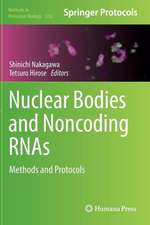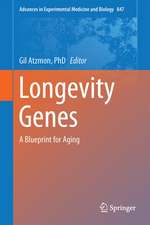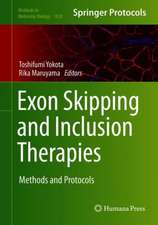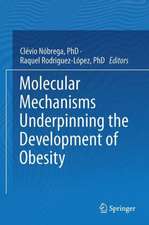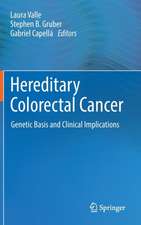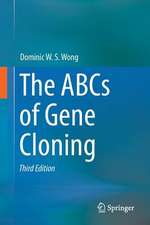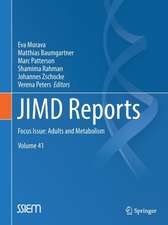RUNX Proteins in Development and Cancer: Advances in Experimental Medicine and Biology, cartea 962
Editat de Yoram Groner, Yoshiaki Ito, Paul Liu, James C. Neil, Nancy A. Speck, Andre van Wijnenen Limba Engleză Hardback – 23 mar 2017
The pleiotropic effects of RUNX in development are mirrored in cancer, where RUNX genes can function as oncogenes that collaborate strongly with Myc family oncogenes or as tumour suppressor genes. In the latter role, they display hallmarks of both ‘gatekeepers’ that modulate p53 responses and ‘caretakers’ that protect the genome from DNA damage. Several chapters focus on the importance of these genes in leukemia research, where RUNX1 and CBFB are frequently affected by chromosomal translocations that generate fusion oncoproteins, while recent studies suggest wider roles for RUNX modulation in solid cancers. Moreover, RUNX genes are intimately involved in the development and regulation of the immune system, while emerging evidence suggests a role in innate immunity to infectious agents, including HIV.
At the biochemical level, the RUNX family can serve as activators or repressors of transcription and as stable mediators of epigenetic memory through mitosis. Not surprisingly, RUNX activity is controlled at multiple levels, this includes miRNAs and a plethora of post-translational modifications. Several chapters highlight the interplay between the three mammalian RUNX genes, where cross-talk and partial functional redundancies are evident. Finally, structural analysis of the RUNX/CBFB interaction has led to the development of small molecule inhibitors that provide exciting new tools to decipher the roles of RUNX in development and as targets for therapy.
This volume provides a compendium and reference source that will be of broad interest to cancer researchers, developmental biologists and immunologists.
| Toate formatele și edițiile | Preț | Express |
|---|---|---|
| Paperback (1) | 1330.95 lei 38-44 zile | |
| Springer Nature Singapore – 9 iun 2018 | 1330.95 lei 38-44 zile | |
| Hardback (1) | 1448.27 lei 3-5 săpt. | |
| Springer Nature Singapore – 23 mar 2017 | 1448.27 lei 3-5 săpt. |
Din seria Advances in Experimental Medicine and Biology
- 9%
 Preț: 719.56 lei
Preț: 719.56 lei - 5%
 Preț: 717.00 lei
Preț: 717.00 lei - 5%
 Preț: 717.00 lei
Preț: 717.00 lei - 15%
 Preț: 640.24 lei
Preț: 640.24 lei - 5%
 Preț: 715.71 lei
Preț: 715.71 lei - 5%
 Preț: 716.28 lei
Preț: 716.28 lei - 20%
 Preț: 691.93 lei
Preț: 691.93 lei - 5%
 Preț: 1031.00 lei
Preț: 1031.00 lei - 5%
 Preț: 820.42 lei
Preț: 820.42 lei - 5%
 Preț: 716.28 lei
Preț: 716.28 lei - 15%
 Preț: 641.38 lei
Preț: 641.38 lei - 5%
 Preț: 717.20 lei
Preț: 717.20 lei - 5%
 Preț: 715.35 lei
Preț: 715.35 lei - 5%
 Preț: 1113.83 lei
Preț: 1113.83 lei - 20%
 Preț: 1161.71 lei
Preț: 1161.71 lei - 5%
 Preț: 1170.51 lei
Preț: 1170.51 lei - 18%
 Preț: 1119.87 lei
Preț: 1119.87 lei - 5%
 Preț: 1288.48 lei
Preț: 1288.48 lei - 5%
 Preț: 1164.67 lei
Preț: 1164.67 lei - 5%
 Preț: 1101.73 lei
Preț: 1101.73 lei - 18%
 Preț: 1123.67 lei
Preț: 1123.67 lei - 5%
 Preț: 1435.64 lei
Preț: 1435.64 lei - 20%
 Preț: 1044.10 lei
Preț: 1044.10 lei - 18%
 Preț: 946.39 lei
Preț: 946.39 lei - 5%
 Preț: 292.57 lei
Preț: 292.57 lei - 18%
 Preț: 957.62 lei
Preț: 957.62 lei - 18%
 Preț: 1235.76 lei
Preț: 1235.76 lei - 5%
 Preț: 1231.55 lei
Preț: 1231.55 lei - 5%
 Preț: 1292.30 lei
Preț: 1292.30 lei - 5%
 Preț: 1102.10 lei
Preț: 1102.10 lei - 18%
 Preț: 1132.81 lei
Preț: 1132.81 lei - 5%
 Preț: 1165.19 lei
Preț: 1165.19 lei - 5%
 Preț: 1418.48 lei
Preț: 1418.48 lei - 5%
 Preț: 1305.63 lei
Preț: 1305.63 lei - 18%
 Preț: 1417.72 lei
Preț: 1417.72 lei - 18%
 Preț: 1412.99 lei
Preț: 1412.99 lei - 24%
 Preț: 806.15 lei
Preț: 806.15 lei - 18%
 Preț: 1243.29 lei
Preț: 1243.29 lei - 5%
 Preț: 1429.44 lei
Preț: 1429.44 lei - 5%
 Preț: 1618.70 lei
Preț: 1618.70 lei - 5%
 Preț: 1305.12 lei
Preț: 1305.12 lei - 18%
 Preț: 1124.92 lei
Preț: 1124.92 lei - 5%
 Preț: 1097.54 lei
Preț: 1097.54 lei - 15%
 Preț: 649.87 lei
Preț: 649.87 lei - 5%
 Preț: 1097.54 lei
Preț: 1097.54 lei - 18%
 Preț: 945.79 lei
Preț: 945.79 lei - 5%
 Preț: 1123.13 lei
Preț: 1123.13 lei - 20%
 Preț: 816.43 lei
Preț: 816.43 lei
Preț: 1448.27 lei
Preț vechi: 1524.48 lei
-5% Nou
Puncte Express: 2172
Preț estimativ în valută:
277.12€ • 289.34$ • 229.36£
277.12€ • 289.34$ • 229.36£
Carte disponibilă
Livrare economică 15-29 martie
Preluare comenzi: 021 569.72.76
Specificații
ISBN-13: 9789811032318
ISBN-10: 9811032319
Pagini: 604
Ilustrații: XX, 515 p. 98 illus., 92 illus. in color.
Dimensiuni: 178 x 254 x 36 mm
Greutate: 1.37 kg
Ediția:1st ed. 2017
Editura: Springer Nature Singapore
Colecția Springer
Seria Advances in Experimental Medicine and Biology
Locul publicării:Singapore, Singapore
ISBN-10: 9811032319
Pagini: 604
Ilustrații: XX, 515 p. 98 illus., 92 illus. in color.
Dimensiuni: 178 x 254 x 36 mm
Greutate: 1.37 kg
Ediția:1st ed. 2017
Editura: Springer Nature Singapore
Colecția Springer
Seria Advances in Experimental Medicine and Biology
Locul publicării:Singapore, Singapore
Cuprins
RUNX in invertebrates.- Structure and biophysics of CBFb/RUNX and its transcription products.- Covalent modification of RUNX proteins: structure affects function.- The role of Runx1 in embryonic blood cell formation.- RUNX1 structure and function in blood cell development.- Roles of Runx2 in skeletal development.- Roles of Runx genes in nervous system development.- Runx family genes in tissue stem cell dynamics.- Roles of RUNX1 enhancer in normal hematopoiesis and leukemogenesis.- RUNX1-ETO leukemia.- Clinical relevance of RUNX1 and CBFB alterations in acute myeloid leukemia and other hematological disorders.- Mechanism of ETV6-RUNX1 leukemia.- ETV6-RUNX1+ acute lymphoblastic leukemia in identical twins.- Molecular basis and targeted inhibition of CBFb-SMMHC acute myeloid leukemia.- The RUNX genes as conditional oncogenes: insights from retroviral targeting and mouse models.- RUNX1 and CBFb mutations and activities of their wild-type alleles in AML.- Roles of RUNX in B cell immortalization.- Roles of RUNX in solid tumors.- RUNX3 and p53: How two tumor suppressors cooperate against oncogenic Ras.- Runx3 and cell fate decisions in pancreas cancer.- RUNX genes in breast cancer and the mammary lineage.- Runx3 in immunity, inflammation and cancer.- Roles of RUNX complexes in immune cell development.- CBFb and HIV infection.- Roles of RUNX in Hippo pathway signaling.- Roles of RUNX in hypoxia-induced responses and angiogenesis.- The emerging roles of RUNX transcription factors in Epithelial-Mesenchymal Transition.- Regulatory role of RUNX1 and RUNX3 in the maintenance of genomic integrity.
Textul de pe ultima copertă
This volume provides the reader with an overview of the diverse functions of the RUNX family of genes. As highlighted in the introduction and several of the 29 chapters, humans and other mammals have three RUNX genes that are known to play specific roles in blood, bone and neuronal development. However, their evolutionary history has recently been traced back to unicellular organisms and their involvement in many well-known signaling pathways (Wnt, TGFb, Notch, Hippo) is indicative of a more general function in cell biology. Their documented roles in cell fate decisions include control of proliferation, differentiation, survival, senescence and autophagy.
The pleiotropic effects of RUNX in development are mirrored in cancer, where RUNX genes can function as oncogenes that collaborate strongly with Myc family oncogenes or as tumour suppressor genes. In the latter role, they display hallmarks of both ‘gatekeepers’ that modulate p53 responses and ‘caretakers’ that protect the genome from DNA damage. Several chapters focus on the importance of these genes in leukemia research, where RUNX1 and CBFB are frequently affected by chromosomal translocations that generate fusion oncoproteins, while recent studies suggest wider roles for RUNX modulation in solid cancers. Moreover, RUNX genes are intimately involved in the development and regulation of the immune system, while emerging evidence suggests a role in innate immunity to infectious agents, including HIV.
At the biochemical level, the RUNX family can serve as activators or repressors of transcription and as stable mediators of epigenetic memory through mitosis. Not surprisingly, RUNX activity is controlled at multiple levels, this includes miRNAs and a plethora of post-translational modifications. Several chapters highlight the interplay between the three mammalian RUNX genes, where cross-talk and partial functional redundancies are evident. Finally, structural analysis of the RUNX/CBFB interaction has led to the development of small molecule inhibitors that provide exciting new tools to decipher the roles of RUNX in development and as targets for therapy.
This volume provides a compendium and reference source that will be of broad interest to cancer researchers, developmental biologists and immunologists.
The pleiotropic effects of RUNX in development are mirrored in cancer, where RUNX genes can function as oncogenes that collaborate strongly with Myc family oncogenes or as tumour suppressor genes. In the latter role, they display hallmarks of both ‘gatekeepers’ that modulate p53 responses and ‘caretakers’ that protect the genome from DNA damage. Several chapters focus on the importance of these genes in leukemia research, where RUNX1 and CBFB are frequently affected by chromosomal translocations that generate fusion oncoproteins, while recent studies suggest wider roles for RUNX modulation in solid cancers. Moreover, RUNX genes are intimately involved in the development and regulation of the immune system, while emerging evidence suggests a role in innate immunity to infectious agents, including HIV.
At the biochemical level, the RUNX family can serve as activators or repressors of transcription and as stable mediators of epigenetic memory through mitosis. Not surprisingly, RUNX activity is controlled at multiple levels, this includes miRNAs and a plethora of post-translational modifications. Several chapters highlight the interplay between the three mammalian RUNX genes, where cross-talk and partial functional redundancies are evident. Finally, structural analysis of the RUNX/CBFB interaction has led to the development of small molecule inhibitors that provide exciting new tools to decipher the roles of RUNX in development and as targets for therapy.
This volume provides a compendium and reference source that will be of broad interest to cancer researchers, developmental biologists and immunologists.
Caracteristici
Provides readers with an overview of the diverse functions of the RUNX family genes Is a compendium and reference source that will be of broad interest to cancer researchers, developmental biologists and immunologists Edited and written by leading scientists from the field







